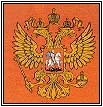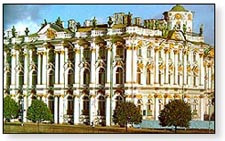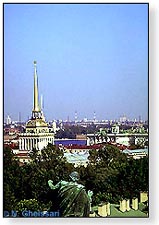 The Hermitage
The Hermitage

 With the possible
exception of the Louvre, there is no museum in the world that rivals the
Hermitage in size and quality. Its collection is so large that it would
take years to view it in its entirety--at last count, there were nearly
three million works on exhibit. The museum is especially strong in Italian
Renaissance and French Impressionist paintings, as well as possessing
outstanding collections of works by Rembrandt, Picasso, and Matisse.
Visitors should also take advantage of its excellent Greek and Roman
antiquities collection and its exhibits of Siberian and Central Asian art.
Not least among the attractions of the Hermitage is the museum itself,
with its fine interior decoration and architectural detail. As the
Hermitage is so enormous, its collection so strong and diverse, and its
interior so attractive in its own right, many visitors find that the very
best way to tour the museum is to make several briefer visits rather than
one frenetic and exhausting marathon tour. While there is much to be
gained by simply allowing the curiosity of one's eye to take at least
occasional precedence over a list of works and collections dictated by a
guidebook or even a guide.
With the possible
exception of the Louvre, there is no museum in the world that rivals the
Hermitage in size and quality. Its collection is so large that it would
take years to view it in its entirety--at last count, there were nearly
three million works on exhibit. The museum is especially strong in Italian
Renaissance and French Impressionist paintings, as well as possessing
outstanding collections of works by Rembrandt, Picasso, and Matisse.
Visitors should also take advantage of its excellent Greek and Roman
antiquities collection and its exhibits of Siberian and Central Asian art.
Not least among the attractions of the Hermitage is the museum itself,
with its fine interior decoration and architectural detail. As the
Hermitage is so enormous, its collection so strong and diverse, and its
interior so attractive in its own right, many visitors find that the very
best way to tour the museum is to make several briefer visits rather than
one frenetic and exhausting marathon tour. While there is much to be
gained by simply allowing the curiosity of one's eye to take at least
occasional precedence over a list of works and collections dictated by a
guidebook or even a guide.
The origins of the Hermitage can be traced back to the private art collection of Peter the Great, who purchased numerous works during his travels abroad and later hung them in his residence. Catherine the Great expanded the collection considerably, and she and her successors built the Hermitage collection in large part with purchases of the private collections of the Western European aristocracy and monarchy. By the time Nicholas II ascended the throne in 1894, he was heir to the greatest collection of art in Europe.
After the Revolution of 1917, the museum was opened to the public, and its collection was further augmented by the addition of modern works taken from private collections. Today, the Hermitage has embarked on a major renovation effort. Its collection is in the process of being reorganized, and many of its works have for the first time become available for travelling exhibits outside of the country.
The Winter Palace
 The Winter Palace is undoubtedly the most
famous building of imperial St. Petersburg, not only as the residence of
the Tsars and the backdrop for the 1905 and 1917 Revolutions, but also as
the home of the Hermitage, the world's largest museum of art.
The Winter Palace is undoubtedly the most
famous building of imperial St. Petersburg, not only as the residence of
the Tsars and the backdrop for the 1905 and 1917 Revolutions, but also as
the home of the Hermitage, the world's largest museum of art.
The present structure, completed in 1762 and designed by Bartolomeo Rastrelli, was commissioned by the Empress Elizabeth. Its opulent baroque facade, stretching two hundred meters, is a veritable cornucopia of pilasters, bays, and statuary. The palace served as the winter residence for every ruler of Russia since Peter III, who installed himself there along with his mistress, the Countess Vorontsova. After his wife Catherine the Great seized the throne, she redecorated and appropriated her husband's old quarters. While her son Nicholas I lived in a modest apartment there, his wife Alexandra commissioned the famously luxurious Malachite Room, later to be used as the meeting place for Kerensky's Provisional Government. Nicholas II had his quarters immediately above this room until 1904, when he moved from the increasingly discontented capital to Tsarskoe Selo. In July of 1917, the Provisional Government took up residence here, thus setting the stage for the October Revolution. After consolidating its power, the Bolshevik government transferred its capital to Moscow, and since that time the Winter Palace has been associated primarily with its role as the Hermitage Museum.
The Russian Museum
Like the Tretyakov Gallery in Moscow, the
Russian Museum contains one of the finest collections of Russian art in
the world. Both museums provide outstanding coverage of the entire history
of Russian art. However, while the Tretyakov knows no peers for its
collection of icons, the Russian Museum's international supremacy is based
on its extensive collection of late 19th and early 20th century Russian
works. One of the best characteristics of the Russian Museum is that it is
organized in a clear chronological progression, thus providing a very good
picture of the major developments in the history of Russian art. Of
particular interest are the ground floor, which covers the nineteenth
century, and the Benois wing, which contains the museum's unparalleled
collection of twentieth century works. Although most of the avant-garde
works of the Benois wing were held in storage after the official embrace
of Soviet realism in the thirties, they have slowly been emerging in
recent years.
St.
Petersburg
Historical Sites | The
Hermitage & The Russian Museum
The Theatres of St. Petersburg | Cathedrals
| Accommodations
Copyright (c) 1996-2005 interKnowledge Corp. All rights reserved.






